A walk-through of American glass styles and inspiration with Peter Wade
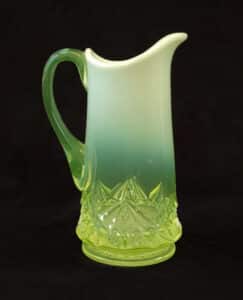
many opalescent colors including this vaseline or uranium variation.
photo: Etsy.com
In the late 1800s, Canary glass was “all the rage” in Victorian households. This glass was a pale yellowish color with a slight tint of green in it. What made it special was the uranium oxide chemical used in the making of the glass. This caused the glass to optically reflect candlelight which helped to increase the amount of light in a candlelit room. Victorians were passionate about this glass. Today, we call this vaseline glass because of its similarity to the color of vaseline ointment. They couldn’t get enough of it. Then, something happened. Or, I should say, someone.
Thomas A. Edison introduced the world to the electric light bulb. Incandescent light had arrived and, in turn, it quickly became the focus amongst Victorians who could now easily light up their households with it. But, something else happened, too. The optical wave light characteristics of electric bulbs didn’t react with the uranium oxide in canary glass.
Almost overnight, reactive vaseline glass went from “must have” to “tired old yellow glass.” Vaseline glass was done – finished by changes in style and new lighting technology.
You can apply variations of this story to just about every stylistic period of glass making, design, collectability, and desirability up to modern times. Financial values went up and down with each stylistic phase. And, when glass values went down, they created a buying opportunity. When they were rediscovered again, the values typically went back up and up.
The heart of the matter is literally what is your passion about glass … the style, form, artistic characteristics, or emotional attributes that are meaningful to you.
Today, you can find and collect glass that will stir your passions and enhance your feelings of well-being. You have an amazing array of styles to choose from and use in decorating your home. And, there’s never been a better time to collect the glass that you want. Currently, the marketplace is offering you a great opportunity to buy the glass you desire.
Styles of Glass: The Victorians – Mid-1800s – 1914
This period of time paralleled the life span of Queen Victoria from her arrival in 1830 to her death in 1901 and to the arrival of World War I in 1914. It was characterized by a materialistic approach, fussy and curvaceous in design, and made thanks to the repetitive machine production of the new industrial age. This period saw several arrivals and transitions in style, fashion, and design, all impacted by advancing technology. It was a period of rapid change.
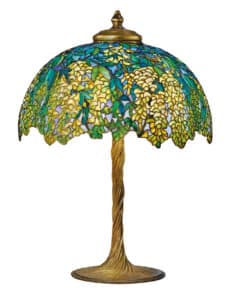
The Aesthetic Movement, which arrived in the mid-1800s, rejected Victorian preferences and introduced the concept of “art for art’s sake” and focused on exploring colors, form, and composition in the pursuit of the beauty that should be part of everyday life. It borrowed from previous sources of inspiration, medieval geometric designs, and Japanese motifs and aesthetics. The French New Art “Art Nouveau” Movement grew out of this. In the world of glass, Emile Gallé, Louis Comfort Tiffany, and Frederick Carder are some of the most famous names who brought this concept to reality in the glass world. Looking back on the Victorian era, it was the Aesthetic Movement that set the stage for the arrival of 20th Century modern art.
This impact would encompass the global marketplace.
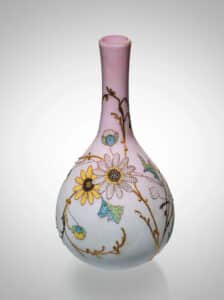
In addition to the famous names mentioned, a whole array of well-known glass companies made the Victorian era a rich and wonderful place for glass collectors to explore. Mount Washington Glass, U.S. Glass, Webb Glass, Stevens & Williams Glass, and many, many more, produced wonderful art glass that is avidly sought after today. This was complemented by the many cut glass companies from the American Brilliant Period.
As technology improved the art of glass making, the production of glass for everyone expanded. Pressed and molded glass makers expanded exponentially. The elegant glass companies: Tiffin, Cambridge, Heisey, Northwood, and Paden City produced beautiful glass affordable to the average family. Some options included hand-blown, mold-blown, and pressed with hand finishing.
Each of these companies has a devoted, passionate following today. They are preserving for future generations the best of what was produced.
The War Years: Art Deco & Art Moderne
The First World War put the glass world on “pause.” When the troops started returning in 1918, there was an explosion of activity on the home fronts. The glass world exploded, too. Everyone was ready for something new and it arrived in the style of Art Deco, or Art Moderne, as the French would call it. The Art Nouveau style had played out, morphing into the Arts and Crafts style of the early 1900s and then into the Art Deco Movement. Art Deco design represented modernism turned into fashion. Its name is derived from the 1925 Paris International Exhibition of Modern Decorative and Industrial Arts.
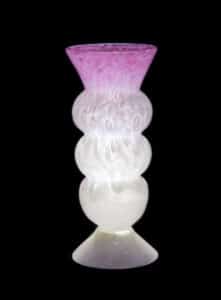
The Biggs Museum of Art through February 20, 2023
Art Deco was influenced by the geometric forms of Cubism and the Vienna Secession, the bright colors of Fauvism, and the exotic styles of the Orient. It featured rare and expensive materials and exquisite craftsmanship. It perfectly fits in with the “Roaring ‘20s.” It was the first truly international art movement. In glass, René Lalique is perhaps the most famous practitioner. Marius Sabino is another famous glass name from this period.
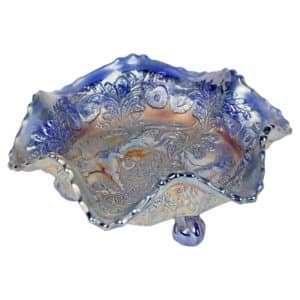
This was also the time when “Modernism” spread throughout the glass world. Scandinavian modernist glass took hold in the
Nordic countries. Orrefors became famous for its “Graal” glass. Nearly every country had a standout company producing exquisite glass designs. Here, in America, you had the works of Frederick Carder and Steuben Glass plus modernist glass from Tiffin, Paden City, Cambridge, Heisey, Imperial, Fenton, and more.
Even though the depression dulled the exuberance of the 1920s, Art Deco design flourished during the 1930s. The ubiquitous depression glass companies made affordable glass for every table and style of decor. Much of this glass is now disappearing. It will become the future of collecting treasures.
Post-War – Mid-Century Modern
World War II brought the heady days of the Art Deco era to an end. The glass market paused and, yet again quickly got going after the war. However, the market had changed. The forces of modernism behind the Art Deco/Art Moderne market were still in force, now accelerated by improvements in technology and design.
Modern glass of this period was defined by its organic shape, sculptural appearance, its color, and the way it reacted to natural light. Its usage was less important, whether for the table or for decorative use.
The shapes and forms of Scandinavian Modernist glass fit this concept perfectly and Scandinavian Modernism soared in its influence with many companies imitating them or using their concepts to launch their own designs.
This was really the beginning of what we now call Mid-Century Glass. Glass from named companies such as Orrefors, Kosta, Stromberg, and Riihimaki are sought after by 1950s and 1960s home furnishings enthusiasts.
Styles of Glass: Mid-Century Modern – Europe & Murano
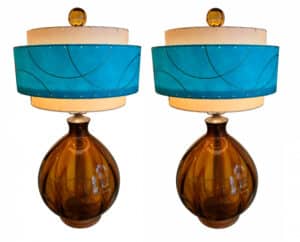
Glass made in Bohemia and Murano pre-date the Mid-Century era by a long shot. Art glass from Loetz easily competes with Tiffany and the French makers. Bohemian art glass from the Victorian era took market share from the American glass companies and made life difficult for some of them. The same is true with respect to Murano glass.
It was after the war, however, that glass from Bohemia and Murano really made inroads into the mainstream American marketplace. Troops brought back souvenirs. Tourists loved Italian glass. Venetian and Murano glass was colorful, innovative, and very popular with collectors. Glass made by Venini and Dino Martens both command premium prices today.
It’s All About Country
Perhaps the two best-known American companies that made glass that complemented the Mid-Century Modern decor were Blenko and Pilgrim glass. Both of these companies made wonderfully innovative and colorful glass that fit into the modernist lifestyle. The glass had brilliant colors, and organic, sculptural designs. It was hand blown and also mold-blown. And, it was mostly unmarked.
By the mid-1950s, the country style became a fashion trend. It didn’t replace the modernist design trends of the mid-century glass movement but offered an alternative.
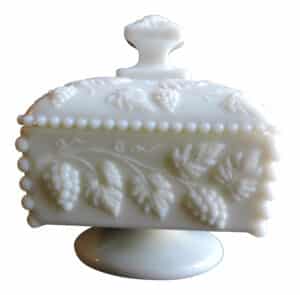
and grape vines that cover the whole outside of the piece.
Fenton Glass was one of the many companies that produced multiple lines of milk glass. This white glass blended nicely with the country style and became very popular.
The country style also witnessed the introduction of whimsical forms of glass, such as figural, and animals. It was a less serious, but “fun” glass.
American Studio Glass Movement
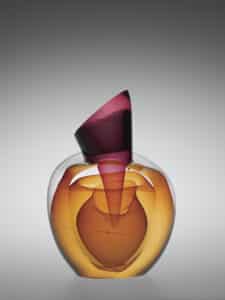
spanned the 1960s to the 1980s.
photo: Corning Museum of Glass
The American Studio Glass Movement began in a small glassblowing workshop on the grounds of the Toledo Museum of Art in 1962 under the guidance of Professor Harvey Littleton, Dominic Labino, and Harvey Leafgreen. The focus of this movement was and still is, on the individual artist as the designer and maker of one-of-a-kind glass objects in a small studio setting. Professor Littleton proved that doing this was a viable
business model.
Originally, before the Industrial Revolution in the 19th Century, glass blowing was done in small workshops by a small number of artisans producing small runs of blown glass. With the Industrial Revolution’s arrival, this kind of small workshop disappeared. Art glass was made in factories, led by a talented designer and a team of skilled workers to produce the basic forms of glass in large quantities. This is how René Lalique, Emile Gallé, and Louis Comfort Tiffany worked. The same is true of the many famous European glass designers.
What we’re seeing today is a return to this original small glass workshop, which has been with us since ancient Roman times and earlier. Examples of this today are the highly collectible works of Lindberg Studios, Lotton Studios, Vandermark Studios, and many others.
Styles of Glass: Contemporary Glass
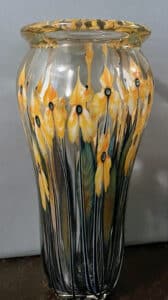
In today’s marketplace, Contemporary Glass is a further refinement of the American Studio Glass Movement. Here, the glass artist is adding “concept” as part of his or her creation of a one-of-a-kind work of glass art. The artist is elevating the art of glass blowing to a higher level of fine art like a painter or sculptor would, producing a work of art for the sake of sculptural enjoyment and visual pleasure.
In many ways, the art of glass blowing has returned to its origins. The large factories that used to produce art glass are fewer today.
The New Historians … Curators & Glass Custodians!
As a collector or buyer of glass, did you know you are the historian, curator, and custodian of the glass treasures that will be saved for the future? You can choose any style, color, or form of glass – make it your passion and contribute to those who will follow. Museums can’t do it alone without you. They don’t have the budget, time, and often, expertise. There are also glass clubs, organizations, and societies that will welcome your passion! Join them!
For a list of collector clubs, click here





Related posts: